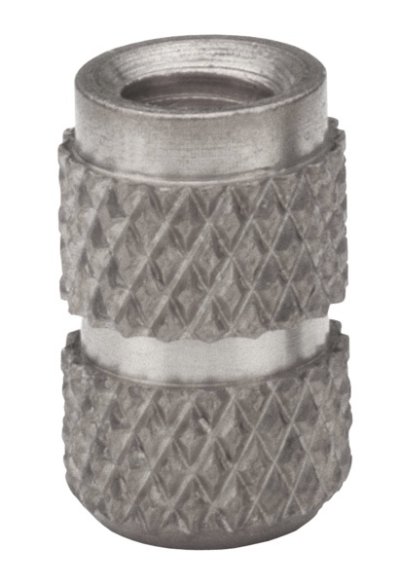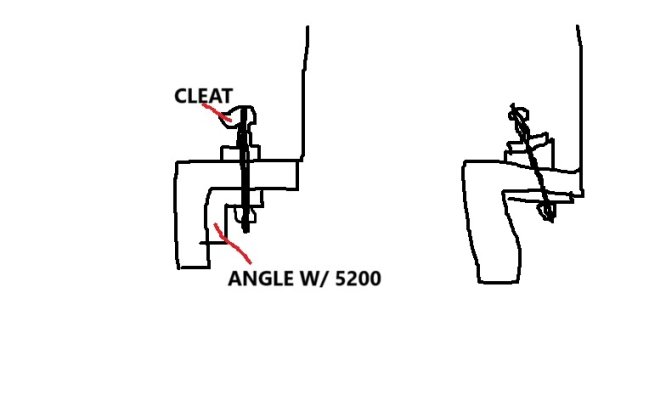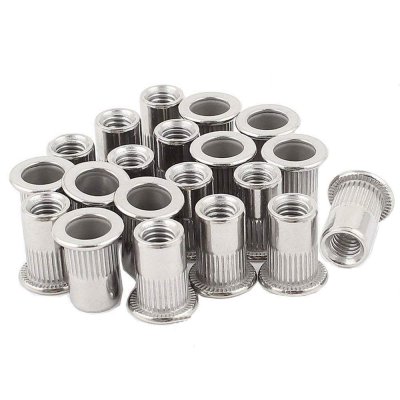You are using an out of date browser. It may not display this or other websites correctly.
You should upgrade or use an alternative browser.
You should upgrade or use an alternative browser.
Mounting stud vs. 4 hole cleats
- Thread starter HeadedToTexas
- Start date
The friendliest place on the web for anyone who enjoys boating.
If you have answers, please help by responding to the unanswered posts.
If you have answers, please help by responding to the unanswered posts.
Circumnavigator
Senior Member
I prefer the inserts that screw in rather than the ones that are driven in as the one above.
There's a trade off -- the insert will be fatter but shorter, so it may or may not offer more lateral resistance.
Jim
There's a trade off -- the insert will be fatter but shorter, so it may or may not offer more lateral resistance.
Jim
HeadedToTexas
Guru
I am familiar with the thread in type, but wouldn't it produce a stronger bond to sink the insert into the epoxy before it sets and allow it to form around all of the contours, threads or otherwise?
rslifkin
Guru
- Joined
- Aug 20, 2019
- Messages
- 7,606
- Location
- USA
- Vessel Name
- Hour Glass
- Vessel Make
- Chris Craft 381 Catalina
I am familiar with the thread in type, but wouldn't it produce a stronger bond to sink the insert into the epoxy before it sets and allow it to form around all of the contours, threads or otherwise?
That's the way I'd want to do it. Insert set in thickened epoxy.
Circumnavigator
Senior Member
Sorry -- I wasn't clear. I would certainly use West Epoxy with 404 filler in either case.
Jim
Jim
mvweebles
Guru
- Joined
- Mar 21, 2019
- Messages
- 7,252
- Location
- United States
- Vessel Name
- Weebles
- Vessel Make
- 1970 Willard 36 Trawler
I'm having a hard time warming to the idea of threaded inserts for cleats to be used for springing a boat, especially where substrate is cored. Maybe if the inserts are very long, but the ones I've seen are under 3/4" Epoxy is pretty brittle. Strong in compression. But I wonder about strength in tension, especially where there is some movement likely. Just seems like it would work loose after a while.
Peter
Peter
Last edited:
rslifkin
Guru
- Joined
- Aug 20, 2019
- Messages
- 7,606
- Location
- USA
- Vessel Name
- Hour Glass
- Vessel Make
- Chris Craft 381 Catalina
I'm having a hard time warming to the idea of threaded inserts for cleats to be used for springing a boat, especially where substrate is cored.
Peter
As long as the insert is long enough to go through enough of the substrate, some amount of core is removed beyond the insert and there's a big plug of thickened epoxy in there (extending under the top skin) it should be a strong install. Certainly stronger than lag bolts, although not as strong as you can achieve with through bolts and a big backing plate, particularly for upward loads.
psneeld
Guru
Epoxy is an adhesive.
Designed to be stronger than most surrounding or attached items.
I believe there are fillers to strengthen areas of small gaps.
I wouldnt worry about the epoxy if done well, it is the surrounding area that would be the issue.
Designed to be stronger than most surrounding or attached items.
I believe there are fillers to strengthen areas of small gaps.
I wouldnt worry about the epoxy if done well, it is the surrounding area that would be the issue.
Last edited:
mvweebles
Guru
- Joined
- Mar 21, 2019
- Messages
- 7,252
- Location
- United States
- Vessel Name
- Weebles
- Vessel Make
- 1970 Willard 36 Trawler
Installation of cleats is a good example of why some boats seem absurdly expensive. Fully backed cleats can be a PITA and since no one will ever know, temptation is to go an easier route that someone 'thinks will work just fine' but has no skin in the game if it doesn't. While rare, having a loaded cleat break free ranks high on the list of life-threatening events on a boat. Not a place to cut corners.
But if someone insists, these inserts have been used in the construction industry for quite a few years now, with special 2-part adhesives designed for their exact installation requirements (albeit frequently concrete which has very little tensile strength). I would look outside the marine industry for this one. Tons of R&D.
Peter
But if someone insists, these inserts have been used in the construction industry for quite a few years now, with special 2-part adhesives designed for their exact installation requirements (albeit frequently concrete which has very little tensile strength). I would look outside the marine industry for this one. Tons of R&D.
Peter
Last edited:
Circumnavigator
Senior Member
Have we lost sight of this application -- two of the four bolts will go though with a heavy backing plate. The other two could go into threaded inserts, epoxied in place. Since all of these are in shear, not tension, that should be OK.
Yes, a cleat failure can be deadly if anyone is standing in line -- that's why I don't use nylon for my spring lines.
A bunch of these failed in the Ted Williams Tunnel a few years ago, killing a woman when an overhead panel fell on her car. Epoxy maker was sued successfully despite its clear instructions never to use it overhead.
Jim
Yes, a cleat failure can be deadly if anyone is standing in line -- that's why I don't use nylon for my spring lines.
A bunch of these failed in the Ted Williams Tunnel a few years ago, killing a woman when an overhead panel fell on her car. Epoxy maker was sued successfully despite its clear instructions never to use it overhead.
Jim
psneeld
Guru
Circumnavigator;1189157[COLOR="Blue" said:]Have we lost sight of this application -- two of the four bolts will go though with a heavy backing plate. The other two could go into threaded inserts, epoxied in place.[/COLOR] Since all of these are in shear, not tension, that should be OK.
Yes, a cleat failure can be deadly if anyone is standing in line -- that's why I don't use nylon for my spring lines.
A bunch of these failed in the Ted Williams Tunnel a few years ago, killing a woman when an overhead panel fell on her car. Epoxy maker was sued successfully despite its clear instructions never to use it overhead.
Jim

But the norm on TF is to always assume hurricanes, bad boat handling and survival situations.
Some people experience all of them on an all to regular (or at least expect to) basis and I wonder why they still boat....

Last edited:
SteveK
Guru
- Joined
- Jul 5, 2019
- Messages
- 5,108
- Location
- Gulf Isalnds BC canada
- Vessel Name
- Sea Sanctuary
- Vessel Make
- Bayliner 4588
But the norm on TF is to always assume hurricanes, bad boat handling and survival situations.
Some people experience all of them on an all to regular (or at least expect to) basis and I wonder why they still boat....
What do you mean, do they actually leave the dock?
mvweebles
Guru
- Joined
- Mar 21, 2019
- Messages
- 7,252
- Location
- United States
- Vessel Name
- Weebles
- Vessel Make
- 1970 Willard 36 Trawler
But the norm on TF is to always assume hurricanes, bad boat handling and survival situations.
Some people experience all of them on an all to regular (or at least expect to) basis and I wonder why they still boat....
Given your background, I'm surprised you'd advocate different levels of work for cleats. I forget if it was this forum or one of the Sailing forums, but a few months ago someone complained that a tow pulled out one of their primary winches. It's reasonable to expect deck hardware is mounted as securely as possible.
Peter
psneeld
Guru
Securely as POSSIBLE. You made my point.
To use the best/strongest method, may require major reconstruction. As long as you know the probables, that should be good enough. Leave notes for the future owners.
You can almost always break a boat or parts of it if you try hard enough.
But you are correct that assistance towers will strongly evaluate if certain hardware looks like it is suitable for needed loads.
One POS boat that overturned in the inlet that I had to tow in..... I ripped almost every piece of hardware out of it until I gave up and used a piece of 4X4 in the front hatch and attached the towline to it. By the time I got to the dock the foredeck was separating from the hull.
It is hard to know what to expect out of a new boats cleats, let alone a used boat...so the real answer is never expect to much out of any of them and assume under good stress they will fail or break (seen plenty of broken cleats where the screws/bolts were still secure...expecially the galvanized dock ones).
To use the best/strongest method, may require major reconstruction. As long as you know the probables, that should be good enough. Leave notes for the future owners.
You can almost always break a boat or parts of it if you try hard enough.
But you are correct that assistance towers will strongly evaluate if certain hardware looks like it is suitable for needed loads.
One POS boat that overturned in the inlet that I had to tow in..... I ripped almost every piece of hardware out of it until I gave up and used a piece of 4X4 in the front hatch and attached the towline to it. By the time I got to the dock the foredeck was separating from the hull.
It is hard to know what to expect out of a new boats cleats, let alone a used boat...so the real answer is never expect to much out of any of them and assume under good stress they will fail or break (seen plenty of broken cleats where the screws/bolts were still secure...expecially the galvanized dock ones).
Last edited:
mvweebles
Guru
- Joined
- Mar 21, 2019
- Messages
- 7,252
- Location
- United States
- Vessel Name
- Weebles
- Vessel Make
- 1970 Willard 36 Trawler
I have no evidence except a ton of construction experience, but I just don't believe inserts qualify as "strong as possible."Securely as POSSIBLE. You made my point.
To use the best/strongest method, may require major reconstruction. As long as you know the probables, that should be good enough. Leave notes for the future owners.
You can almost always break a boat or parts of it if you try hard enough.
But you are correct that assistance towers will strongly evaluate if certain hardware looks like it is suitable for needed loads.
One POS boat that overturned in the inlet that I had to tow in..... I ripped almost every piece of hardware out of it until I gave up and used a piece of 4X4 in the front hatch and attached the towline to it. By the time I got to the dock the foredeck was separating from the hull.
It is hard to know what to expect out of a new boats cleats, let alone a used boat...so the real answer is never expect to much out of any of them and assume under good stress they will fail or break (seen plenty of broken cleats where the screws/bolts were still secure...expecially the galvanized dock ones).
Love the visual of a 4x4 in the forward hatch of a boat......
Peter
psneeld
Guru
I have no evidence except a ton of construction experience, but I just don't believe inserts qualify as "strong as possible."
Love the visual of a 4x4 in the forward hatch of a boat......
Peter
Unless I am mistaken, won't they be sharing the load with 2 bolts and backing plates?
If they are sharing with bolts and based on the proximity to the boat structure .....look at the probable stress on them and my guess that in almost all cases the major leverage will be at the rear of the cleat and on the bolts.
Without a clear picture/understanding of what is underneath, I could see a 3rd option.... 5200 a piece of angle against the inside of the hull and the botton of the deck, then use the cleat with 2 bolts. You probably would pull the deck off first if the angle had a good bond with the 5200 and both surfaces.
Another possibility is put the cleat on an angle to get the bottom of the bolts more to the center of the backing plate. The picture doesn't show it but the backing plate would need the mirror image shim.
Attachments
Last edited:
HeadedToTexas
Guru
I hadn’t thought about using angle stock as a backing plate, though the G10 plates I have for this project are ½” thick and will provide a very sound purchase against the outer side of the hull as shown in your left diagram above. Those two fasteners will get the same through bolted security with either type of cleat.
If the 4 hole cleat has an advantage, it is in the extra two fasteners. Any contribution from those extra two seems like a benefit.
Finding tall or long inserts has not been fruitful. Suppose I threaded two of these together “bottom to bottom” and sank them in still wet slow set epoxy thickened with glass mat cut into strips? That would be nearly 3” of glass reinforced stainless insert penetrating both outer and inner skins and the core area filled with epoxy.
If the 4 hole cleat has an advantage, it is in the extra two fasteners. Any contribution from those extra two seems like a benefit.
Finding tall or long inserts has not been fruitful. Suppose I threaded two of these together “bottom to bottom” and sank them in still wet slow set epoxy thickened with glass mat cut into strips? That would be nearly 3” of glass reinforced stainless insert penetrating both outer and inner skins and the core area filled with epoxy.
Attachments
Similar threads
- Replies
- 12
- Views
- 1K
- Replies
- 10
- Views
- 1K



